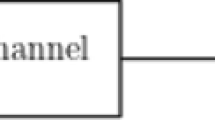Abstract
Two reduced-complexity decoding algorithms for unitary space-time codes based on tree-structured constellation are presented. In this letter original unitary space-time constellation is divided into several groups. Each one is treated as the leaf nodes set of a subtree. Choosing the unitary signals that represent each group as the roots of these subtrees generates a tree-structured constellation. The proposed tree search decoder decides to which sub tree the receive signal belongs by searching in the set of subtree roots. The final decision is made after a local search in the leaf nodes set of the selected sub tree. The adjacent subtree joint decoder performs joint search in the selected sub tree and its “surrounding” subtrees, which improves the Bit Error Rate (BER) performance of purely tree search method. The exhaustively search in the whole constellation is avoided in our proposed decoding algorithms, a lower complexity is obtained compared to that of Maximum Likelihood (ML) decoding. Simulation results have also been provided to demonstrate the feasibility of these new methods.
Similar content being viewed by others
References
B. M. Hochwald, T. L. Marzetta. Unitary space-time modulation for multiple-antenna communications in Rayleigh flat fading. IEEE Trans. on Inform. Theory, 46(2000)2, 543–564.
D. P. Liu, Q. T. Zhang, Qiming Chen. Structures and performance of non-coherent receivers for unitary space-time modulation on correlated fast-fading channels. IEEE Trans. on Vehicular Technology, 53(2004)4, 1116–1125.
I. Bahceci, T. M. Duman. Trellis-coded unitary space-time modulation. IEEE Trans. on Wireless Commun., 3(2004)6, 2005–2012.
Qian Ma, C. Tepedelenlioglu. Antenna selection for unitary space-time modulation. IEEE Trans. on Inform. Theory, 51(2005)10, 2620–2631.
B. M. Hochwald, T. L. Marzetta, T. J. Richardson, et al. Systematic design of unitary space-time constellations. IEEE Trans. on Inform. Theory, 46(2000)6, 1962–1973.
D. Agrawal, T. J. Richardson, R. L. Urbanke. Multiple-antenna signal constellations for fading channels. IEEE Trans. on Inform. Theory, 47(2001)6, 2618–2626.
M. L. McCloud, M. Brehler, M. K. Varanasi. Signal design and convolutional coding for noncoherent space-time communication on the block-Rayleigh-fading channel. IEEE Trans. on Inform. Theory, 48(2002)5, 1186–1194.
Author information
Authors and Affiliations
Corresponding author
Additional information
Supported by the National Natural Science Foundation of China (No.60572148).
About this article
Cite this article
Su, X., Yi, K., Tian, B. et al. Reduced-complexity decoding algorithms for unitary space-time codes. J. of Electron.(China) 24, 112–115 (2007). https://doi.org/10.1007/s11767-006-0062-0
Received:
Revised:
Published:
Issue Date:
DOI: https://doi.org/10.1007/s11767-006-0062-0




